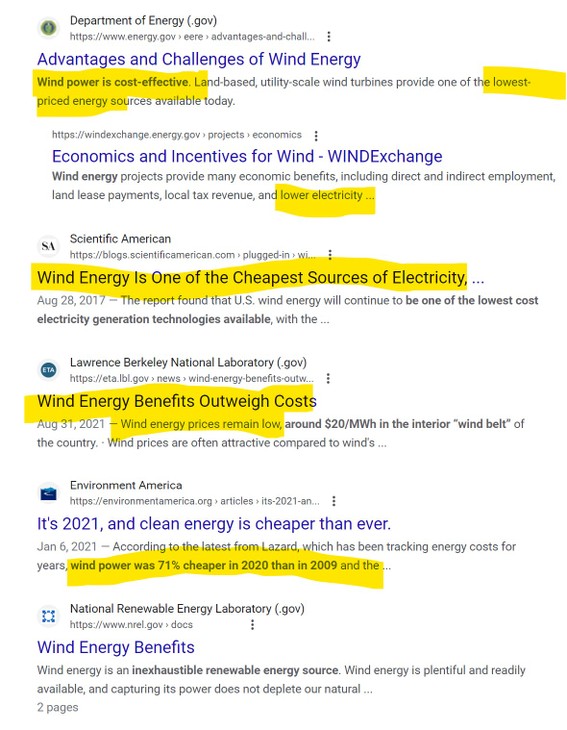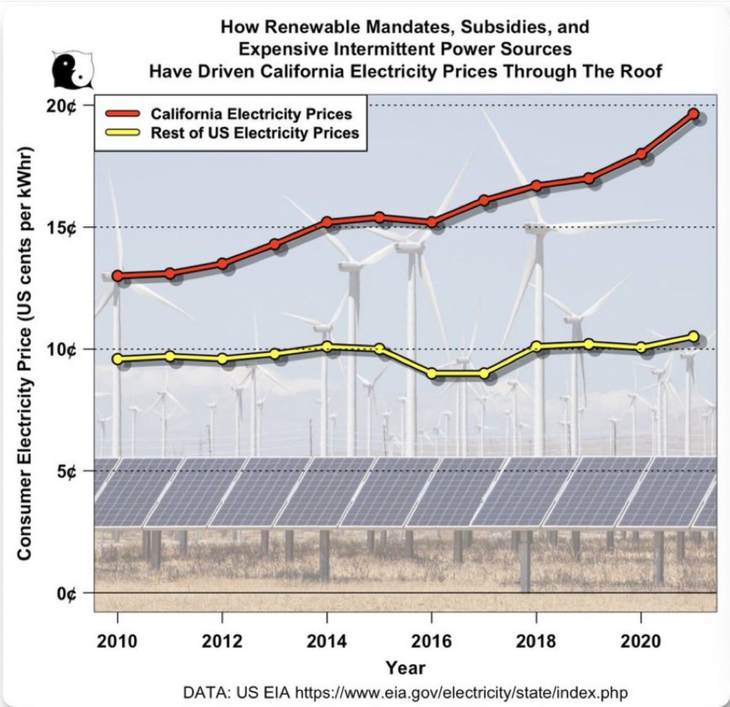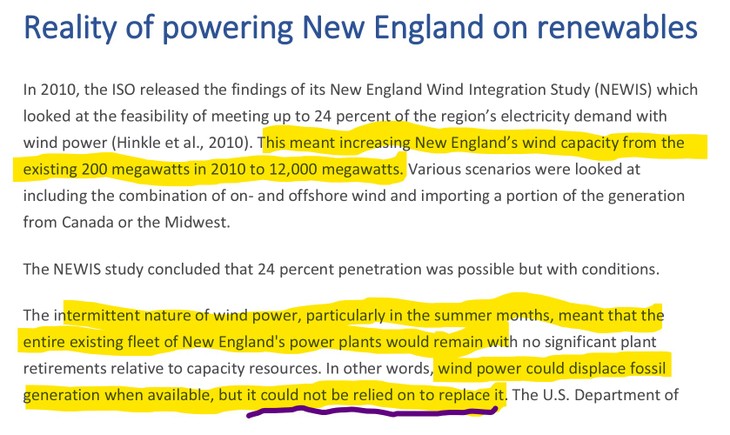If the chickens wouldn’t get hacked into a million tiny, bloody bits, you could certainly say they were coming home to roost on the Green fraud that is wind power, wind turbines, renewables, wonk, wonk, wonk. In particular the offshore component, which is billed as the least invasive, biggest savior of all the wind farm Green scheming.
As currently sold to greedy, gullible politicians and earnest, but simple minded lemmings as more efficient and friendly to a catastrophically warming planet, the natural advantages of using a readily available resource trump fossil fuels powered plants in both reliability and affordability. The wind and sun are free, we were and are told. One only has to wire something up that transmits the harnessed power and everyone will rejoice we did so.

We’re still hearing that now – cast your ears towards the painful pleadings of advocates for offshore wind farms in California. The onshore ones they have have been working out so well for CA consumers, no?

“Oh, if we only get umptyphrats amount more turbines, everything will work out!” It’s all unicorn farts, as I noted in a June post about Gavin Newsom already scrambling to lock on external sources of energy to keep power flowing to his state this summer. His plans, by the way, will be put to the test this coming week, cuz it’s going to be hot.
CA residents’ electric bills will reflect all those savings from renewables.
The U.K. Labour party is stubbornly pursuing even more wind, even as years of wind driven energy price hikes belie the promises made during their forced transition to Gaia Green renewables.
In the renewable energy industry hope ever springs eternal, with Australia and the US forging ahead with plans to build a host of offshore wind turbines just as the UK is realising its large offshore wind sector is only adding to its power woes.
After years of assurances from renewable energy advocates that the UK’s offshore wind farm sector will deliver cheap and plentiful power, with the equivalent of more than 15 gigawatts of capacity now installed, the country’s power prices are amongst the highest in all Europe.
A major reason for the increase is the price of gas, with wholesale power from gas plants three times more expensive than before the crisis, according to the UK media, but wind power is simply adding to the problem. By some estimates power from the offshore turbines is even more expensive than gas power during the crisis.
“Oooo, but look!” say advocates. “It’s that nasty gas making it expensive!” You can’t have wind power without the gas, dreamers. Wind doesn’t always blow. An unstable source is an expensive source.
…It has been noted in many publications that household electricity prices are higher in countries with a larger share of wind and solar in electricity generation [1-6]. The primary reason [3,4.5] appears to be the intermittent nature of wind and solar – variable renewable energies (VRE). They do not necessarily produce enough energy when societies need it and too much energy when they do not.
The price of turbines, materials, warranty issues, and installation snafus have driven those tower prices through the roof.
As of 2020, they were also identifying corrosion problems with ocean wind farm foundation installations they hadn’t anticipated. Who knew sea water would eat metal and such things up? Manufacturers were all doing their own thing – you’ll note there are “no industry standards” for corrossion prevention – and certain performance parameters were “assumed.” (Now, I know what I’ve been told about ASSuming anything….)
…Presently, the authors note, precise guidelines for internal corrosion protection of monopile wind turbine foundations are not provided in current industry standards, and the corrosion protection strategy for the internal surfaces is up to the individual owners or designers. In early projects, additional material thickness for corrosion allowance was used as corrosion protection for the internal surfaces. The monopile foundation’s closed-compartment design was assumed to be completely air- and watertight, and low, uniform corrosion rates were anticipated. In a completely airtight structure, the dissolved oxygen (DO) in seawater would be quickly consumed by uniform corrosion on the entire steel surface, and corrosion rates would decrease as the seawater became anaerobic.
Industry experience has shown, however, that it is difficult in practice to completely seal compartments and render them airtight. If the closed-compartment structure is not properly sealed, direct ingress of air is possible. Seawater and oxygen ingress have been detected in foundations that are two to 10 years old, which increased the rate of corrosion and localized corrosion attacks. Furthermore, in some cases, the increasing water level has led to the internal aluminum ladder acting as a sacrificial anode (Figure 2).
These unexpected contradictions to design expectations were discovered during inspections and surveys related to grout failures that caused the settling of the transition piece on the monopile in a large number of northern European wind farms…
But let’s build more, shall we? Keep ASSuming the next fix will work.
Closer to home, and perhaps most eye-popping of all, a study released last month on energy costs in the state of Massachusetts and the New England energy corridor relative to consumer usage and renewables had to have climate cultists covering their heads with an ethically sourced, sustainable bamboo blanket.
New Study: Annual Cost of MA Renewable Energy Policies has Quadrupled in 10 Years
…The study found that New England has experienced an 11.4 percent drop in annual energy demand from 2008 to 2020, yet New Englanders pay 20 percent more on average for each kilowatt hour of electricity delivered to their homes. The study found that as renewable energy and climate policy requirements expand, the costs for ratepayers have increased. This outcome suggests that the promise of alternative energies lowering and stabilizing rates has not been realized.
The study’s announcement is complete with figures about how much has been spent, what it has cost taxpayers to date, and how very difficult it is to get concrete information out of the various agencies involved – “For projects where information is available…” – to quantify future costs in shoving this down people’s throats. I can’t imagine why those figures would be difficult to obtain, can you?
…If the region’s climate policies are followed to their expected conclusion of zero emission energy, it will require substantially more ratepayer support and more land and ocean development to accommodate the wind, solar, and transmission infrastructure needed within New England. Yet reporting on these impacts is generally limited, and where available it’s often difficult for the public to follow. It is crucial for all, particularly the ratepayers who are shouldering the brunt of the costs, to be engaged in an honest and informed debate about the region’s energy future.
…“We are seeing energy consumption decrease, while prices are increasing along with layer after layer of arbitrary mandates for more renewables. The annual cost of Massachusetts renewable energy policies has quadrupled in 10 years. Our region’s renewable energy mandates are some of the most complex and costly in the entire country. We now have twenty-six separate programs across the six states, with nine in Massachusetts. As these separate programs continue to grow, so does the cost for ratepayers,” continued Craney.
“Ratepayers in New England are repeatedly told emission-free electricity will lower costs and benefit the environment. In fact, under the current energy policies, New Englanders will continue to see rate increases that will fund the industrialization of the region’s rich natural areas both on- and offshore, stated Lisa Linowes, an energy analyst and author of the study.
The cold splash of water in one section probably chilled the renewable lobby to the bone, God forbid should the public became aware. Curiously, though…did you ever hear about this survey? Any of these figures? There ya go.
They made sure this news wound up sleepin’ with tha fishes.


Let me do that math for you real quick. As of 2022, New England had just a shade over 7K Mw of combined wind and solar. What the survey found was in order to meet the decarbonization goals the states have already committed themselves to, they will need to increase that capacity, plus battery storage, to 89,000Mw, spend $19-$25B (2010 dollars – can’t imagine now), and still will face winter power shortages.
I think my calculator just exploded.








Join the conversation as a VIP Member